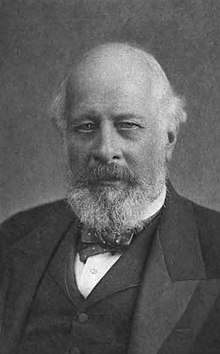Frederick Leveson-Gower (Bodmin MP)
Edward Frederick Leveson-Gower DL, JP (3 May 1819 – 30 May 1907),[1] styled The Honourable from birth, was a British barrister and Liberal politician. He was commonly known under his second forename and was sometimes nicknamed Freddy Leveson.[2]
Frederick Leveson-Gower DL, JP | |
|---|---|
 | |
| Member of Parliament for Bodmin | |
| In office 1859–1885 | |
| Preceded by | Hon. John Vivian James Wyld |
| Succeeded by | Leonard Henry Courtney |
| Member of Parliament for Stoke-upon-Trent | |
| In office 1852–1857 Serving with John Ricardo | |
| Preceded by | William Taylor Copeland John Ricardo |
| Succeeded by | William Taylor Copeland John Ricardo |
| Member of Parliament for Derby | |
| In office 1847–1847 | |
| Preceded by | John Ponsonby Edward Strutt |
| Succeeded by | Michael Thomas Bass Lawrence Heyworth |
| Personal details | |
| Born | Edward Frederick Leveson-Gower 3 May 1819 |
| Died | 30 May 1907 (aged 88) |
| Spouse(s) | Lady Margaret Compton
( m. after 1851, died) |
| Relations | William Cavendish, 5th Duke of Devonshire (grandfather) Granville Leveson-Gower, 2nd Earl Granville (brother) |
| Children | George Granville Leveson-Gower |
| Parents | Granville Leveson-Gower, 1st Earl Granville Lady Harriet Elizabeth Cavendish |
| Education | Eton College |
| Alma mater | Christ Church, Oxford |
Early life
Leveson-Gower was the second surviving son of Granville Leveson-Gower, 1st Earl Granville and his wife Lady Harriet Elizabeth Cavendish, second daughter of William Cavendish, 5th Duke of Devonshire.[3] He spent his early childhood, first in his father's residence at Wherstead, and when his father had become ambassador in France in 1824, at the British embassy in Paris, where he was a playmate of Henri, comte de Chambord.[2]
Aged eight, he was sent back to England on a school in Brighton, after which he entered Eton College.[2] Leveson-Gower left the latter in 1835 and was privately educated for the next two years, until he went on Christ Church, Oxford in 1837.[2] He graduated with a Bachelor of Arts in 1840 and a Master of Arts four years later.[4]
Career
After his Grand Tour, he was then called to the bar by the Inner Temple in 1845, practising in the Oxford circuit.[4]
Leveson-Gower entered the British House of Commons for Derby with the support of his uncle William Cavendish, 6th Duke of Devonshire in May 1847. However, the election was overturned on petition in July and Leveson-Gower did not stand in the by-election.[5] From 1851, he worked as précis writer in the Foreign Office until the following year,[4] when by the influence of his cousin George Sutherland-Leveson-Gower, 2nd Duke of Sutherland, he stood successfully as a Member of Parliament (MP) for Stoke-upon-Trent. In 1856, Leveson-Gower joined his brother Granville on a special mission to Russia.[4] He lost his seat, however, in the general election of 1857.[1]
Two years later, he was returned for Bodmin and represented the constituency until his retirement from politics in 1885.[6] Leveson-Gower was a Justice of the Peace for Surrey and served as a Deputy Lieutenant for the county.[7]
Personal life
Having travelled to India in 1850, Leveson-Gower, after his return, married Lady Margaret Compton, daughter of Spencer Compton, 2nd Marquess of Northampton, on 1 June 1851.[4] She died only a few years later.[4] Their only son:
- George Granville Leveson-Gower (1858–1951), who later in the Parliament of the United Kingdom for North West Staffordshire and also for Stoke-upon-Trent. He married the Hon. Adelaide Violet Cicely Monson, daughter of Debonnaire John Monson, 8th Baron Monson.[8]
He died in 1907, aged 88, having been in his later life a friend of William Ewart Gladstone and his wife.[2]
References
- "Leigh Rayment - British House of Commons, Stoke-upon-Trent". Archived from the original on 3 October 2018. Retrieved 9 October 2009.
- Russell, George W. E. (2007). Prime Ministers and Some Others. Teddington: The Echo Library. p. 63. ISBN 1-4068-4104-8.
- Fox-Davies, Arthur Charles (1895). Armorial families. Edinburgh: Grange Publishing Works. p. 610.
- Debrett, John (1881). Robert Henry Mair (ed.). Debrett's House of Commons and Judicial Bench. London: Dean & Son. p. 96.
- "Leigh Rayment - British House of Commons, Derby". Archived from the original on 3 October 2011. Retrieved 9 October 2009.
- "Leigh Rayment - British House of Commons, Bodmin". Archived from the original on 10 August 2009. Retrieved 9 October 2009.
- M. G. Wiebe; Mary S. Millar; John Alexander; Wilson Gunn, eds. (2004). Benjamin Disraeli Letters: 1857-1859 (2nd ed.). Toronto: University of Toronto Press Inc. p. 80. ISBN 0-8020-8728-0.
- "ThePeerage - Hon. Edward Frederick Leveson-Gower". Retrieved 15 February 2009.
External links
- Hansard 1803–2005: contributions in Parliament by Edward Levenson-Gower
- Portraits of (Edward) Frederick Leveson-Gower at the National Portrait Gallery, London

| Parliament of the United Kingdom | ||
|---|---|---|
| Preceded by John Ponsonby Edward Strutt |
Member of Parliament for Derby May–July 1847 With: Edward Strutt |
Succeeded by Michael Thomas Bass Lawrence Heyworth |
| Preceded by William Taylor Copeland John Ricardo |
Member of Parliament for Stoke-upon-Trent 1852–1857 With: John Ricardo |
Succeeded by William Taylor Copeland John Ricardo |
| Preceded by Hon. John Vivian James Wyld |
Member of Parliament for Bodmin 1859–1885 With: William Michell 1859 James Wyld 1859–1868 |
Succeeded by Leonard Henry Courtney |